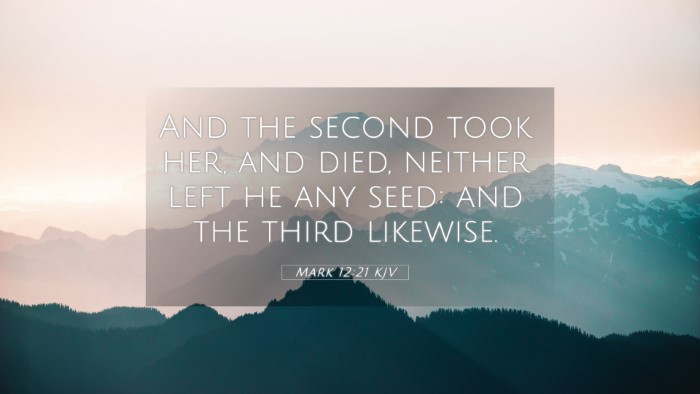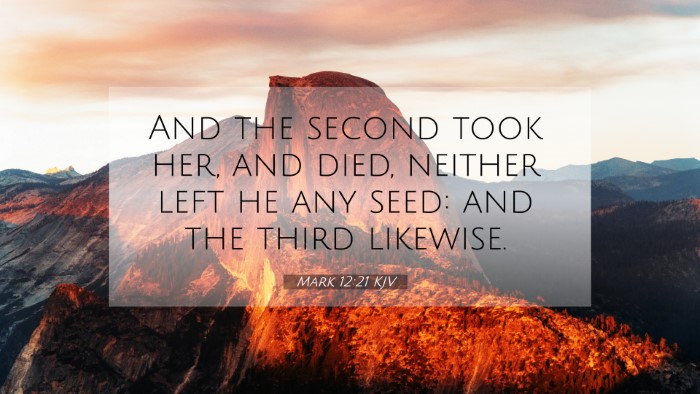Summary and Interpretation
This verse is part of a discourse where Jesus responds to the Sadducees regarding the topic of resurrection. The Sadducees, who denied the resurrection, present a hypothetical situation about a man who dies childless. This verse emphasizes the importance of lineage and the practice of levirate marriage, where a brother is obligated to marry his deceased brother's widow to preserve the family line.
- Significance of Levirate Marriage: The practice is rooted in the laws given to the Israelites, emphasizing the continuity of family heritage and divine blessings through progeny.
- Cultural Context: This concept illustrates the social and familial structures prevalent in ancient Israel and highlights God's concern for family and community.
- Spiritual Implications: This verse also points to the broader theological theme of resurrection as Jesus later clarifies that life continues beyond this earthly existence.
Cross References to Consider
- Deuteronomy 25:5-6: The original law regarding levirate marriage.
- Genesis 38:8: The example of Judah and Tamar, demonstrating the practice in action.
- Ruth 4:1-10: Boaz as a kinsman-redeemer for Ruth, showing the application of the principle.
- Matthew 22:24-28: A parallel account of the Sadducees questioning Jesus about the resurrection.
- Luke 20:29-33: Another synoptic gospel account discussing the same question posed by the Sadducees.
- 1 Timothy 5:14: A New Testament reference to the importance of family and marriage.
- Hebrews 11:17-19: The faith of Abraham, linking lineage and divine promise.
- Galatians 3:29: Discussing that we are all heirs through Christ, connecting to the idea of spiritual lineage.
- Ephesians 1:4-5: The concept of being chosen and predestined in God's family.
- Romans 8:15-17: The assurance of being children of God correlating to the themes in Mark 12:21.
Thematic Connections
This verse exemplifies several key thematic messages in the Bible:
- God's Design for Family: It underscores the importance of familial obligations and heritage.
- The Resurrection of the Dead: The Sadducees' ignorance about resurrection is challenged, implying a continuous existence after death.
- The Nature of God’s Law: Insight into how laws given to Israel reflect God's character and concerns for His people.
Comparative Bible Verse Analysis
When using tools for Bible cross-referencing, one can identify how passages like Mark 12:21 resonate across other scriptures. For example, Jesus’ rebuke of the Sadducees not only clarifies misunderstanding of legalities but also instills a deeper understanding of life after death, echoing throughout the New Testament.
Understanding through Cross-References
By cross-referencing, students of Scripture can find enriching insights into how marriage, family, and resurrection tie together the Old and New Testament teachings. This cross-referencing Bible study facilitates a comprehensive understanding of doctrinal themes as well as practical applications for today's believers.
Tools and Resources
For those seeking to deepen their study, utilizing a Bible concordance and a Bible cross-reference guide can enhance understanding of these interconnected themes:
- How to use Bible cross-references: Identify key themes and concepts across different books.
- Bible reference resources: Explore studies that compile various scriptures dealing with similar ideas.
- Bible chain references: Follow the thematic links between verses to build a cohesive study on resurrection, family, and obligations.


